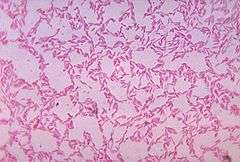Bacteroidia
The class Bacteroidia is composed of a single order of environmental bacteria. By far, the Bacteroidales order are the most well-studied of the Bacteroidetes. Some members of the genus Bacteroides are opportunistic pathogens.[1] Before the fourth volume of Bergey's Manual of Systematic Bacteriology came out, it was referred to as class Bacteroidetes.[2]
| Bacteroidia | |
|---|---|
 | |
| Bacteroides biacutis anaerobically cultured in blood agar medium | |
| Scientific classification | |
| Domain: | Bacteria |
| Phylum: | Bacteroidetes |
| Class: | Bacteroidia |
| Orders | |
| |
It includes members which are common in the human gastrointestinal microbiota, including Prevotella and Bacteroides.
References
- Bergey's Manual of Systematic Bacteriology, 2nd ed., vol. 1 (The Archaea and the deeply branching and phototrophic Bacteria) (D.R. Boone and R.W. Castenholz, eds.), Springer-Verlag, New York (2001). pp. 465-466.
- Krieg, N.R.; Ludwig, W.; Whitman, W.B.; Hedlund, B.P.; Paster, B.J.; Staley, J.T.; Ward, N.; Brown, D.; Parte, A. (November 24, 2010) [1984(Williams & Wilkins)]. George M. Garrity (ed.). The Bacteroidetes, Spirochaetes, Tenericutes (Mollicutes), Acidobacteria, Fibrobacteres, Fusobacteria, Dictyoglomi, Gemmatimonadetes, Lentisphaerae, Verrucomicrobia, Chlamydiae, and Planctomycetes. Bergey's Manual of Systematic Bacteriology. 4 (2nd ed.). New York: Springer. p. 908. ISBN 978-0-387-95042-6. British Library no. GBA561951.
This article is issued from
Wikipedia.
The text is licensed under Creative
Commons - Attribution - Sharealike.
Additional terms may apply for the media files.